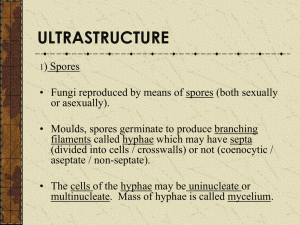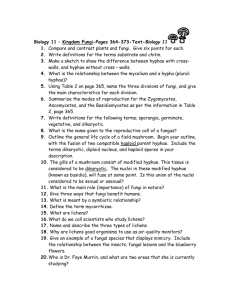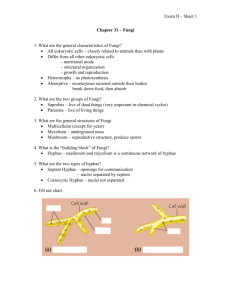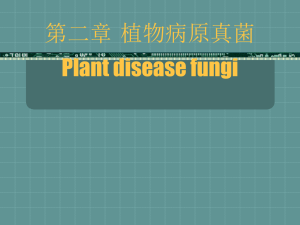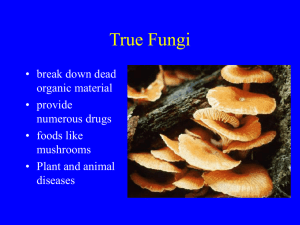Fungi - Biology Junction
advertisement
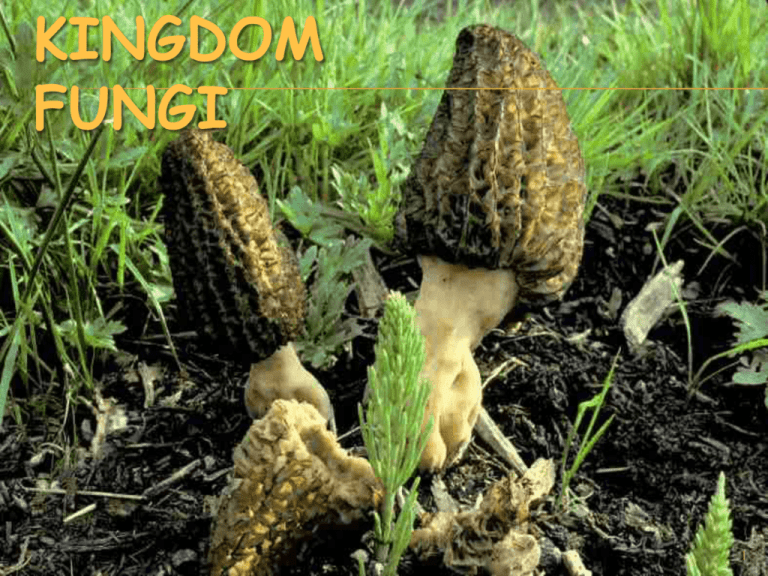
KINGDOM FUNGI 1 Characteristics 2 THE CHARACTERISTICS OF FUNGI Fungi are NOT plants Nonphotosynthetic Eukaryotes Nonmotile Most are saprobes (live on dead organisms) 3 THE CHARACTERISTICS OF FUNGI Absorptive heterotrophs (digest food first & then absorb it into their bodies Release digestive enzymes to break down organic material or their host Store food energy as glycogen BREAD MOLD 4 THE CHARACTERISTICS OF FUNGI Important decomposers & recyclers of nutrients in the environment Most are multicellular, except unicellular yeast Lack true roots, stems or leaves MULTICELLULAR MUSHROOM UNICELLULAR YEAST 5 THE CHARACTERISTICS OF FUNGI Cell walls are made of chitin (complex polysaccharide) Body is called the Thallus Grow as microscopic tubes or filaments called hyphae 6 THE CHARACTERISTICS OF FUNGI Some fungi are internal or external parasites A few fungi act like predators & capture prey like roundworms Predaceous Fungi feeding on a Nematode (roundworm) 7 THE CHARACTERISTICS OF FUNGI Some are edible, while others are poisonous EDIBLE POISONOUS 8 THE CHARACTERISTICS OF FUNGI Produce both sexual and asexual spores Classified by their sexual reproductive structures Spores come in various shapes 9 THE CHARACTERISTICS OF FUNGI Grow best in warm, moist environments Mycology is the study of fungi Mycologists study fungi A fungicide is a chemical used to kill fungi Fungicide kills leaf fungus 10 THE CHARACTERISTICS OF FUNGI Fungi include puffballs, yeasts, mushrooms, toadstools, rusts, smuts, ringworm, and molds The antibiotic penicillin is made by the Penicillium mold Penicillium mold Puffball 11 Vegetative Structures NON-REPRODUCTIVE 12 HYPHAE Tubular shape ONE continuous cell Filled with cytoplasm & nuclei Multinucleate Hard cell wall of chitin also in insect exoskeletons 13 HYPHAE Stolons – horizontal hyphae that connect groups of hyphae to each other Rhizoids – rootlike parts of hyphae that anchor the fungus STOLON RHIZOIDS 14 HYPHAE Cross-walls called SEPTA may form compartments Septa have pores for movement of cytoplasm Form network called mycelia that run through the thallus (body) 15 ABSORPTIVE HETEROTROPH Fungi get carbon from organic sources Tips of Hyphae release enzymes Enzymatic breakdown of substrate Products diffuse back into hyphae Nucleus “directs” the digestive process Digested material is then used by the hypha MODIFICATIONS OF HYPHAE Fungi may be classified based on cell division (with or without cytokinesis) Aseptate or coenocytic (without septa) Septate (with septa) NO CROSS WALLS CROSS WALLS 17 MODIFICATIONS OF HYPHAE HAUSTORIA – parasitic hyphae on plants & animals Septate Hyphae Coenocytic Hyphae 18 HYPHAL GROWTH Hyphae grow from their tips Mycelium is an extensive, feeding web of hyphae Mycelia are the ecologically active bodies of fungi This wall is rigid Only the tip wall is plastic and stretches 19 REPRODUCTIVE STRUCTURES ASEXUAL & SEXUAL SPORES 20 REPRODUCTION Most fungi reproduce Asexually and Sexually by spores ASEXUAL reproduction is most common method & produces genetically identical organisms Fungi reproduce SEXUALLY when conditions are poor & nutrients scarce 21 SPORES Spores are an adaptation to life on land Ensure that the species will disperse to new locations Each spore contains a reproductive cell that forms a new organism Nonmotile Dispersed by wind 22 SEXUAL REPRODUCTION 23 SEXUAL REPRODUCTION Used when environmental conditions are poor (lack of nutrients, space, moisture…) No male or female fungi Some fungi show dimorphism May grow as MYCELIA or a YEAST –LIKE state (Filament at 25oC & Round at 37oC) Dimorphic Fungi 24 SEXUAL REPRODUCTION Haploid 1n hyphae from 2 mating types (+ and -) FUSE (Fertilization) Forms a hyphae with 2 nuclei that becomes a ZYGOTE The zygote divides to make a SPORE + SPORE FORMS 25 ASEXUAL REPRODUCTION 26 THREE TYPES OF ASEXUAL REPRODUCTION Fragmentation – part of the mycelium becomes separated & begins a life of its own Budding – a small cell forms & gets pinched off as it grows to full size Used by yeasts Asexual spores – production of spores by a single mycelium 27 REPRODUCE BY SPORES Spores may be Formed: Directly on hyphae Inside sporangia On Fruiting bodies Penicillium hyphae Amanita fruiting body Pilobolus sporangia ASEXUAL REPRODUCTION Fruiting Bodies are modified hyphae that make asexual spores An upright stalk called the Sporangiosphore supports the spore case or Sporangium 29 ASEXUAL REPRODUCTION Types of Fruiting Bodies: Basidia Sporangia Ascus Sporangia Basidia 30 Fruiting Bodies Both are composed of hyphae mycelium 31 HYPHAL GROWTH FROM SPORE Germinating spore mycelium Mycelia have a huge surface area More surface area aids digestion & absorption of food 32 Evolution of Fungi 33 CLADOGRAM Which of the following is most closely related to a mushroom (fungus)? WHY? Recent DNA-based studies show that fungi are more similar to animals than to plants 34 Evolution of the Fungi IT’S ALL ABOUT THE SPORES! Fungi are classified by their REPRODUCTIVE STRUCTURES and SPORES The reproductive structures are: BASIDIA - BASIDIOMYCOTA SPORANGIA - ZYGOSPORANGIA ASCUS - ASCOMYCOTA 36 IT’S ALL ABOUT THE SPORES! Spores are made of: Dehydrated cytoplasm Protective coat Haploid cell Wind, animals, water, & insects spread spores Spores germinates when they land on a moist surface (new hyphae form) 37 asci zygosporangia motile spores basidia Classification & Phylogeny 38 Major Groups of Fungi 39 MAJOR GROUPS OF FUNGI Within the past few years, several groups have been re-classified into the protists Two of these groups are the slime molds and water molds Classification by Nutrition Saprobes Decomposers Molds, mushrooms, etc. Parasites Harm host Rusts and smuts (attack plants) Mutualists Both benefit Lichens Mycorrhizas 41 MAJOR GROUPS OF FUNGI Basidiomycota – Club Fungi Zygomycota – Bread Molds Chytridiomycota – Chytrids AM Fungi - Mycorrhizas Ascomycota – Sac Fungi Lichens – Symbiosis (algae & Fungi) ZYGOMYCOTA 43 ZYGOMYCOTA Called the sporangium fungi Commonly called molds Also includes blights Hyphae have no cross walls (aseptate) Grow rapidly Includes bread mold Rhizopus stolonifer Rhizopus on strawberries Tomato Blight ZYGOMYCOTA Asexual reproductive structure called sporangium atop sporangiospores make spores Rhizoids anchor the mold & release digestive enzymes & absorb food Stolons connect the fruiting bodies ZYGOMYCOTA Sexual spores are produced by conjugation when (+) hyphae and (-) hyphae fuse Sexual spores are called ZYGOSPORES Zygospores can endure harsh environments until conditions improve zygospore BASIDIOMYCOTA 47 BASIDIOMYCOTA Called Club fungi Includes: Mushrooms Toadstools Bracket & Shelf fungi Puffballs Stinkhorns Rusts and smuts USES FOR BASIDIOMYCOTA Some are used as food (mushrooms) Others damage crops (rusts & smuts) Corn Smut Portobello Mushrooms Soybean Rust CHARACTERISTICS OF CLUB FUNGI Seldom reproduce asexually The visible mushroom is a fruiting body Basidiocarp (fruiting body) is made of a stalk called the stipe and a flattened cap with gills called Basidia underneath Basidiospores are found on basidia Annulus is a skirt-like ring around some stipes Vegetative structures found below ground 50 Hyphal fusion mycelium and fruiting of haploid body are dikaryotic mycelia haploid mycelium MUSHROOM LIFE CYCLE N Meiosis 2N N+N Nuclear fusion in basidium young basidia - the only diploid cells Fig 31.12 51 ASCOMYCOTA 52 CHARACTERISTICS Called Sac fungi Includes Cup fungi, morels, truffles, yeasts, and mildew May be plant parasites (Dutch elm disease and Chestnut blight) Reproduce sexually & asexually Ascus - sac that makes ascospores in sexual reproduction Specialized hyphae known as Ascocarps contain the asci CHARACTERISTICS Yeasts reproduce asexually by budding (buds break off to make more yeast cells) Asexual spores called conidia form on the tips of special hyphae called conidiophores CONIDIA CONIDIA FORMATION 55 YEASTS BUDDING Saccharomyces USES OF ASCOMYCETES Truffles and morels are good examples of edible ascomycetes Penicillium mold makes the antibiotic penicillin. Some ascomycetes also gives flavor to certain cheeses. Saccharomyces cerevesiae (yeast) is used to make bread rise and to ferment beer & wine. CHYTRIDIOMYCOTA 58 CHYTRIDIOMYCOTA Called chytrids Produce motile spores Mostly saprobes and parasites in aquatic habitats Biodegrade and recycle nutrients Chytrid that attacks Potatoes MYCORRHIZA 60 MYCORRHIZAS Fungus associated with plant roots Mutualism between: Fungus (nutrient & water uptake for plant) Plant (carbohydrate for fungus) Several kinds: Zygomycota – hyphae invade root cells Ascomycota & Basidiomycota – hyphae invade root but don’t penetrate cells Extremely important ecologically 61 LICHENS 62 LICHENS Mutualism between: Fungus (structure) Algae or cyanobacteria (provides food) Form a thallus (body) Foliose Fruticose Crustose LICHEN STRUCTURE 64 LICHENS AS BIOMONITORS Thalli act like sponges Some species more sensitive than others to pollutants Which species are present can indicate air quality Most resistant species can also be analyzed for pollutants 65 66


